Bridger - 2012
'09 maps for:
Bea
--
Buck -- Caley --
Claws --
Conomo --
Hix --
Hudson 09 -- Isabel --
Katy -- L.R. --
Moffet --
Mr. Hannah --
Ozzie --
Penelope
--
Rafael
2010 maps for: Belle
-- Buck --
Gunny --
Hudson --
Mr. Hannah --
Neale --
North Fork Bob
--
Penelope --
Sanford
-- Sr. Bones --
Thatch
2011 maps:
Belle --
Buck --
Henrietta --
Katbird
-- North Fork Bob --
Pemi --
Saco --
Sanford --
Sr. Bones --
Snowy --
Thatch -- Tucker
2012 maps: Art -- Belle -- Bridger --
Chip -- Cutch --
Jill -- North Fork Bob --
Rammie -- Snowy --
Sr. Bones -- Thatch
2013 maps: Art --
Belle --
Bridger --
North Fork Bob --
Rammie --
Snowy --
Sr. Bones
Osprey
main page --
Migration
page --
Migration09 --
Migration10 --
Migration 11 --
Migration 12 --
Migration 13 -- Home
Page
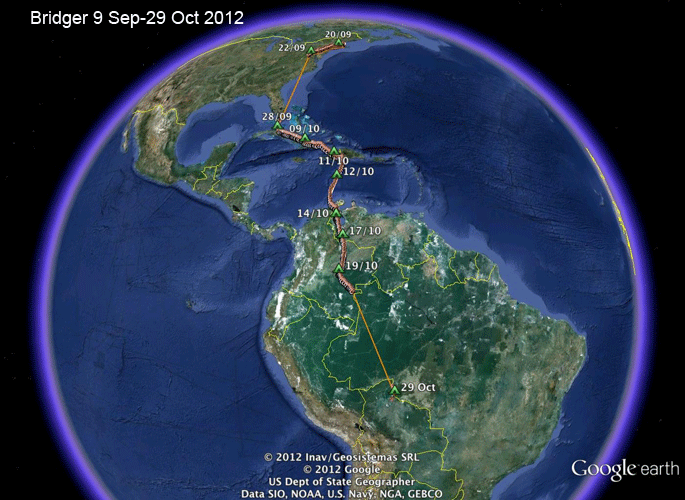 |
19 Sep-29 Oct 2012 -
After almost a month of radio silence, we got a
signal from Bridger's PTT, relayed from a cell
tower way down in the Amazonian rainforest in
southern Colombia! We don't know how he got from Virginia to Cuba--we should get this data back when we recapture Bridger in the spring. His track is exactly what we expect from an adult Osprey--Cuba to Hispaniola to Cabo Beata to Colombia and then to some place in South America. And then 9 days later he found another cell tower in Bolivia. |
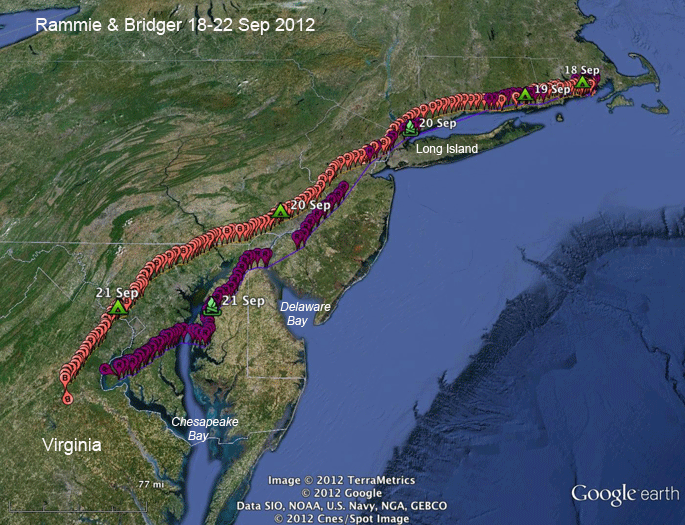 |
18-22 Sep 2012 -
Bridger and his neighbor Rammie were both
inspired by the same north winds to take off for
points south. Bridger left on the 19th, and
Rammie on the 20th. Scroll down for all the maps for Bridger and his neighbor Rammie, or... Skip to the start of fall migration, but... Don't miss this map if you haven't seen our new analyses of where the boys are spending their nights. |
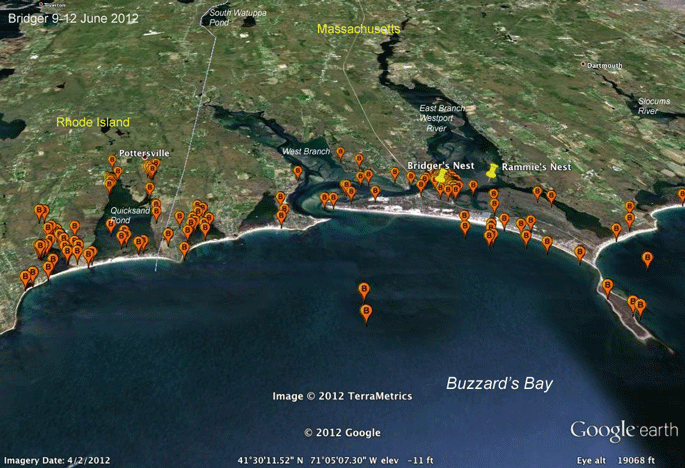 |
9-12 June 2012 -
"Bridger" is an adult male with the first nest
you see when you pass under the bridge in
Westport heading up the East Branch of the
river. His mate is nothing short of ferocious.
She, like many other Ospreys in this colony
recognize the boat that the research crew uses
to visit nests on the river's marshes. Any other
boat gets free passage, but when the research
boat comes into view, she rockets off the nest
and follows the boat. If you happen to be
visiting her nest, you need to hold a canoe
paddle over your head, if you want to get back
on the boat with it still attached! (That's
obviously a bit of an exaggeration, but not much
of one!). Alan Poole and I trapped her and her mate on June 7th. Her mate, Bridger, got one of our new GPS transmitters that text home via cell phone towers! We get lots more data this way than when we rely on satellites to get the data. These are the spots where Bridger was hunting during the first few days after we tagged him. The two points out in Buzzards Bay are 1.7 miles offshore. He was almost certainly working a school of menhaden, a.k.a bunker. When we bought some fish to put in the nests where we trapped (a peace offering) the owner of the bait shop allowed as to how menhaden were in the area, but he wasn't disclosing where, lest the industrial menhaden trawlers get wind of them. Anyone interested in Ospreys and coastal ecology should read Bruce Franklin's The Most Important Fish in the Sea. If you have an iPhone or some other way to do books on tape, buy the recorded version. It's cheaper than the book and read by the author. His passion for the subject is so apparent and makes for a wonderful listen. |
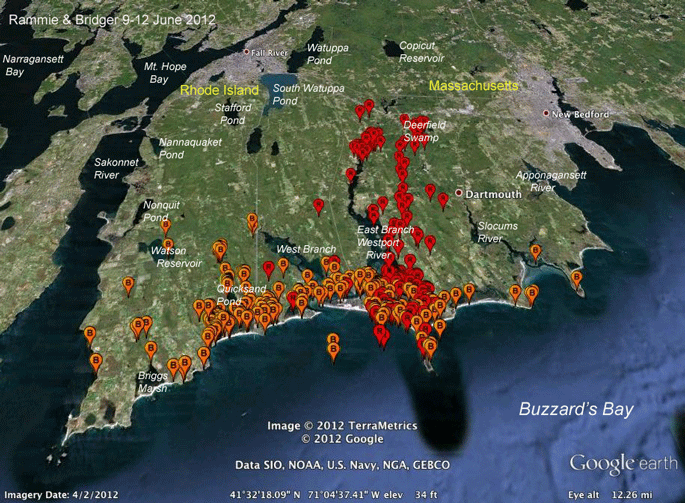 |
9-12 June 2012 -
[Same text here on Rammie's page] Here are the
points for both Bridger and his neighbor,
Rammie, during the first 3 days after they got
their high-tech backpacks. Note that Rammie was
also out after some pogies. While they agreed
that fishing for menhaden was an option, what is
most striking about this map is how different
their fishing behavior is. This is why we're tagging adult males. The GPS transmitters, and especially the new "cell-tower" transmitters, provide a remarkably detailed picture of how these birds are using the environment. This is just what we have seen when we followed neighboring Ospreys from the Westport River colony in years past--just like human fisherpeople, each Osprey has its favorite fishing holes. Rammie is apparently working the herring run on the headwaters of the East Branch, while Bridger is hugging the coast. |
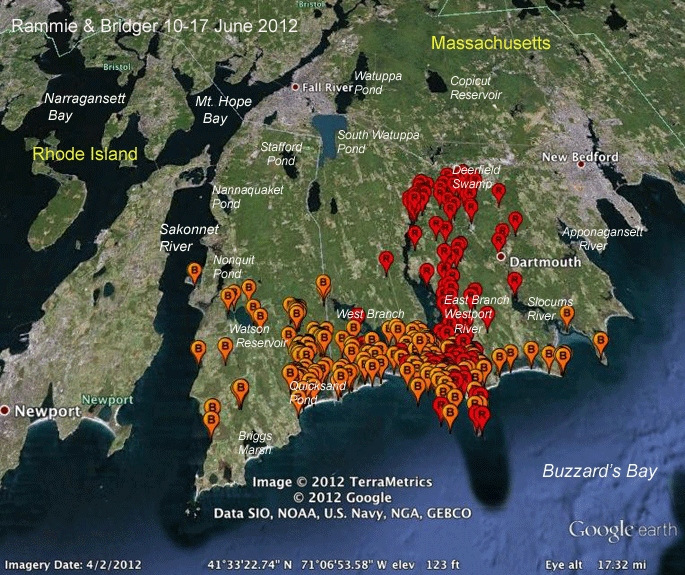 |
10-17 June 2012 -
The next series of maps are weekly snapshots of
where both birds were hunting. Notice that this week and next both birds were hunting out in Buzzards Bay quite a bit. Probably taking advantage of some menhaden (or pogies or bunker--this all-important species of fish has a whole lot of names). |
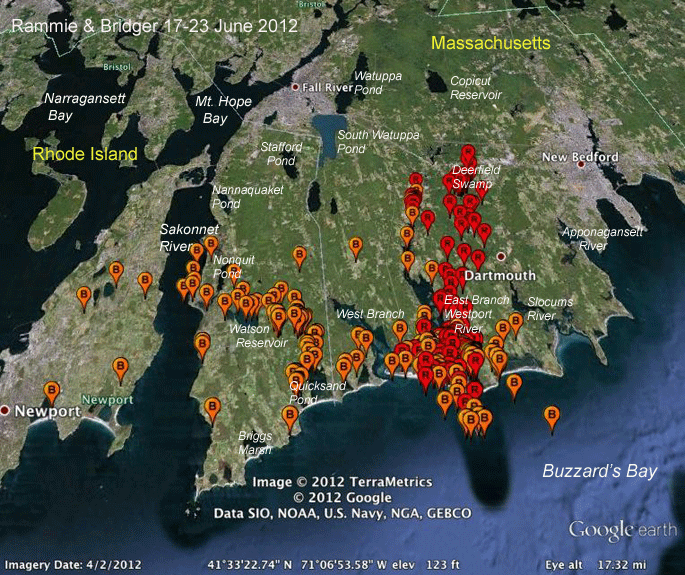 |
17-23 June 2012 -
Both birds are still hunting off shore in
Buzzards Bay, but Bridger is also working west
over into Rhode Island. He even made a few
forays across the Sakonnet River to Newport. Rammie has found a little pond up in the Deerfield Swamp that he really likes. |
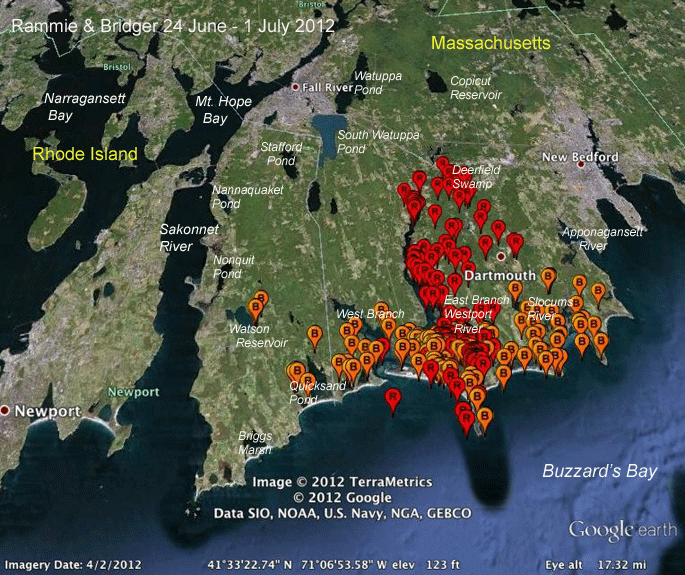 |
24 June - 1 July 2012 - Rammie is sticking to his battle plan, while Bridger has made a big shift in his foraging and is now working hard east of the Westport River around the mouth of Slocums River. |
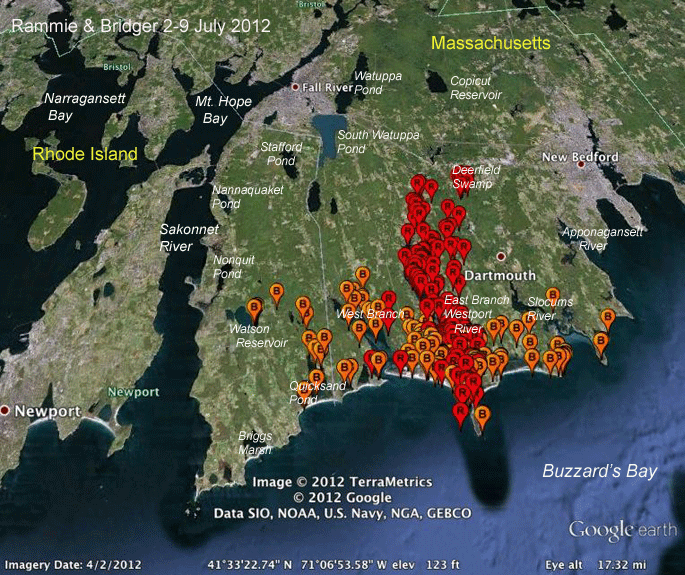 |
2-9 July 2012 - Whatever Bridger was catching east of the Westport River seems to have moved on. Rammie just keeps working the East Branch and his favorite fishing hole up in the Deerfield Swamp. |
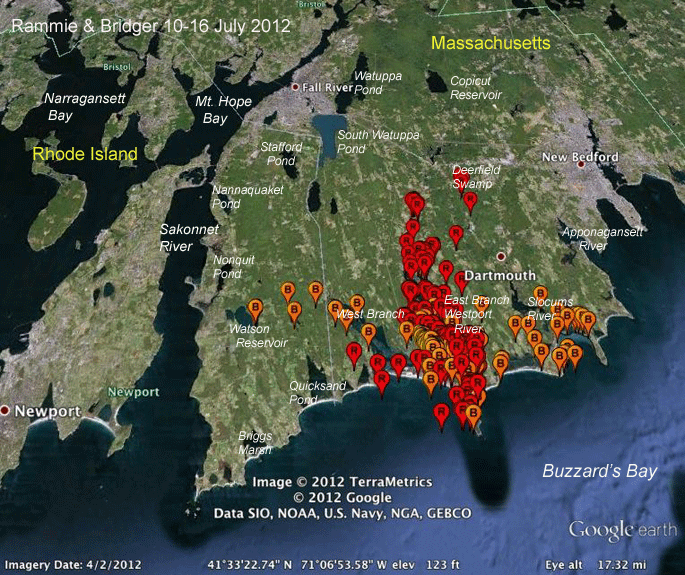 |
10-16 July 2012 - "Same old same old" for Rammie, while Bridger is back at the mouth of Slocums River. |
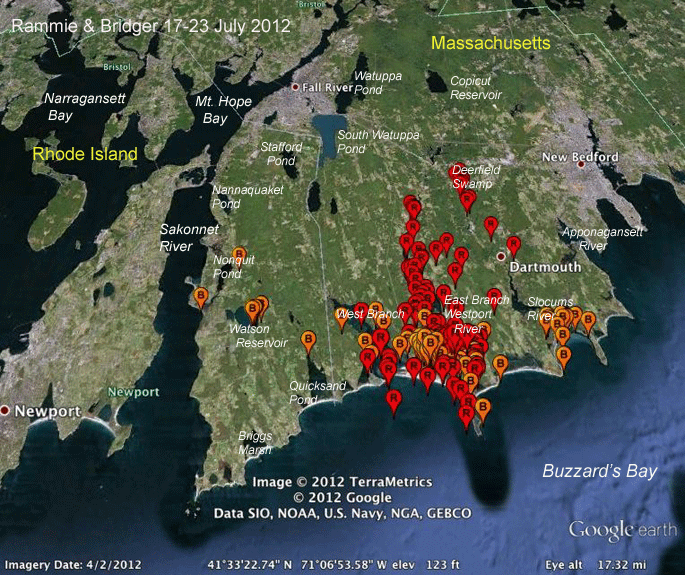 |
17-23 July 2012 - I had to double check to be sure this wasn't the same map as the week before. Bridger is feeding 3 young, while Rammie is providing fish for two young. |
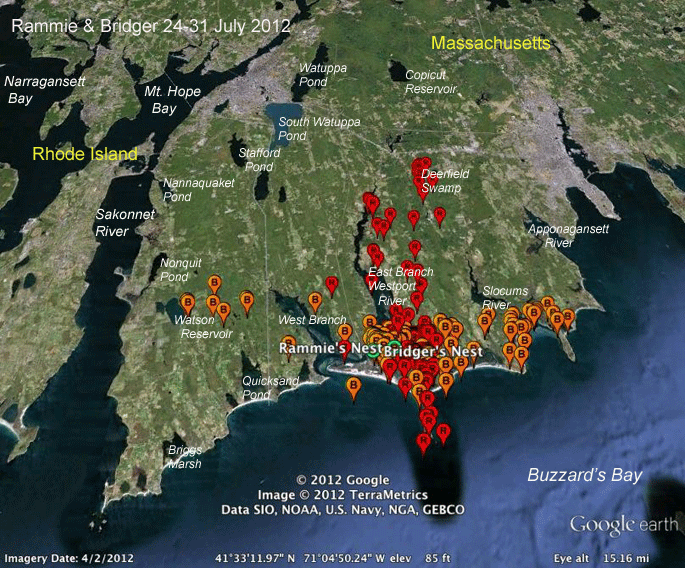 |
24-31 July 2012 - Pretty much the same activity as last week. |
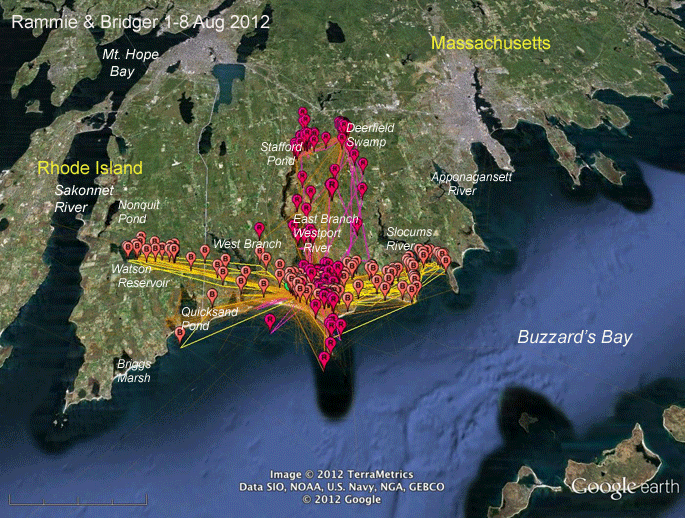 |
1-8 Aug 2012 - Looks like the fishing hasn't changed again. Bridger's working Watson Reservoir and the mouth of Slocums River pretty heavily, while Rammie's still working the upper reaches of the East Branch, Deerfield Swamp, and some open water out in Buzzards Bay. |
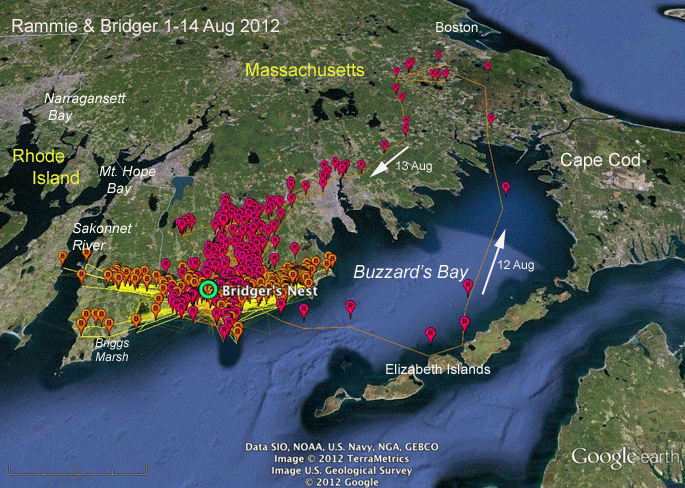 |
1-14 Aug 2012 - Wow, didn't see that coming! On the 12th Rammie went on a big road trip almost all the way to Boston. He didn't waste any time along the way. He left the Westport late afternoon (about 6PM) on the 12th, flew over to the Elizabeth Islands and then back across Buzzards Bay up to Carver, MA, where he arrived at about 8PM. Apparently he wasn't very impressed with the area, as he left around 8AM the next morning. |
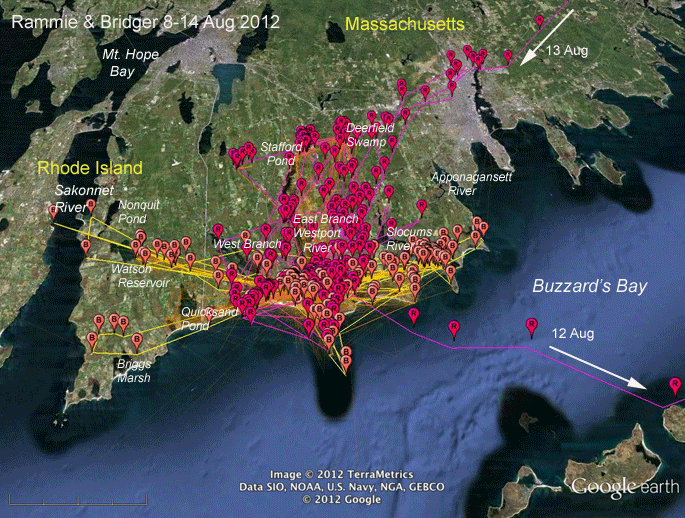 |
8-15 Aug 2012 -
Here's a closer look at what was going on back
on the home front during the week. While it's impossible to tell from this view, Rammie wasn't spending much time around his nest. Either his young died, or they moved out of the area. It would be early for a young to start migrating, but some will leave the nest for extended periods about this stage of the summer. No change for Bridger, who's still feeding 3 hungry youngsters. |
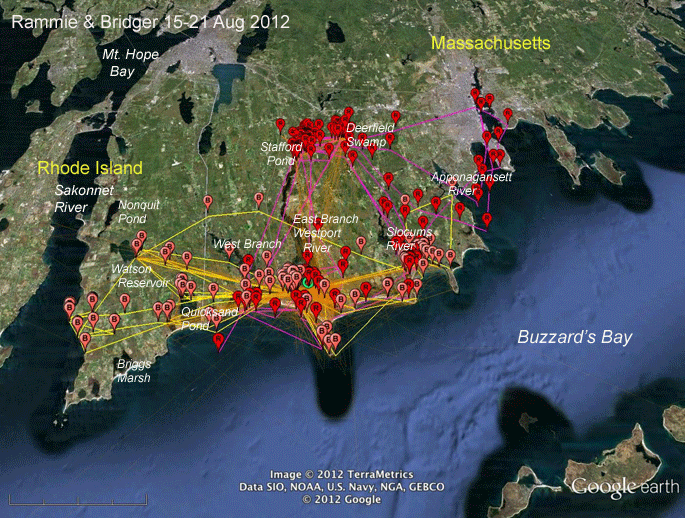 |
15-21 Aug 2012 - Rammie spent very little time around his nest this week. And although he still likes the upper reaches of the East Branch and Deerfield Swamp, apparently word got out about the good fishing that Bridger has been enjoying at the mouth of Slocums River. |
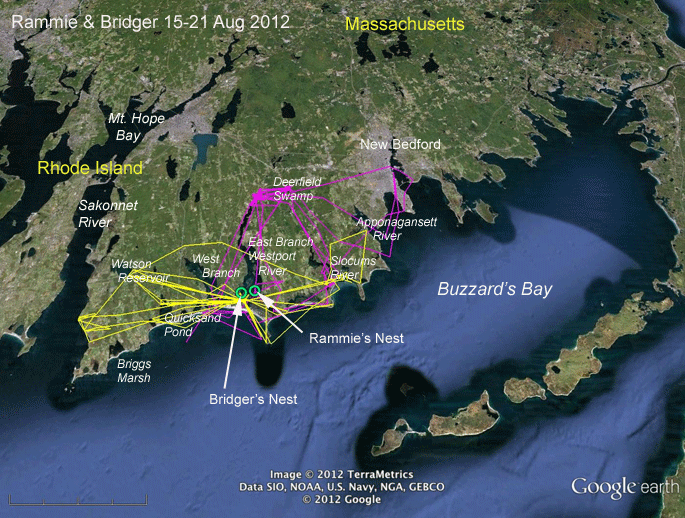 |
15-21 Aug 2012 - Here's that same data with just the tracks visible. It's much more obvious here that Rammie's not tied to the nest anymore. |
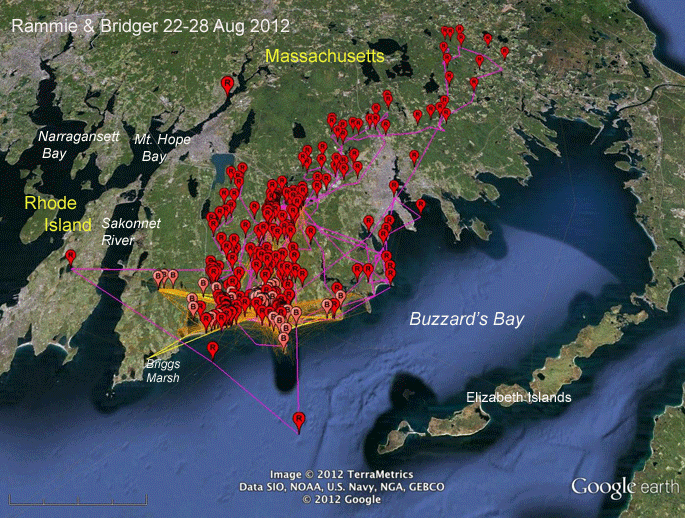 |
22-28 Aug 2012 - Rammie's all over the place! Out over the open water of Buzzards Bay and back on another road trip up towards Boston. Bridger's stayed pretty close to home during the week. |
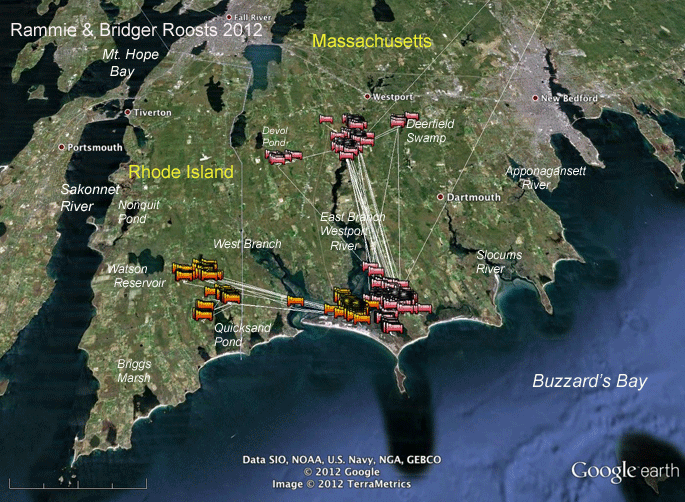 |
2012 -
Totally new map here. Because of our new
cell-tower based transmitters, we're getting
tons more data than we ever have before,
including locations during the night. This means
that for the first time we know for certain
where our birds are sleeping, and the results
are very interesting, indeed. Each bed (I couldn't resist) represents a GPS location between 10PM and 3:59AM for Bridger (yellow) and Rammie (pink). The lines just connect roost locations and do not indicate real flight paths. So, it turns out the the boys often spend the night far from their nests. Not surprisingly, these remote roosts are close to each bird's favorite fishing spot. One particularly interesting observation is that both birds always roosted close to their nests for almost all of July. This would be the time when the young were just about to fledge or had just begun to fly. Is this heightened attention to the nest area because at this point the males have so much invested in their young that any increased vigilance around the nest will have a big return? This is ground ripe for speculation! |
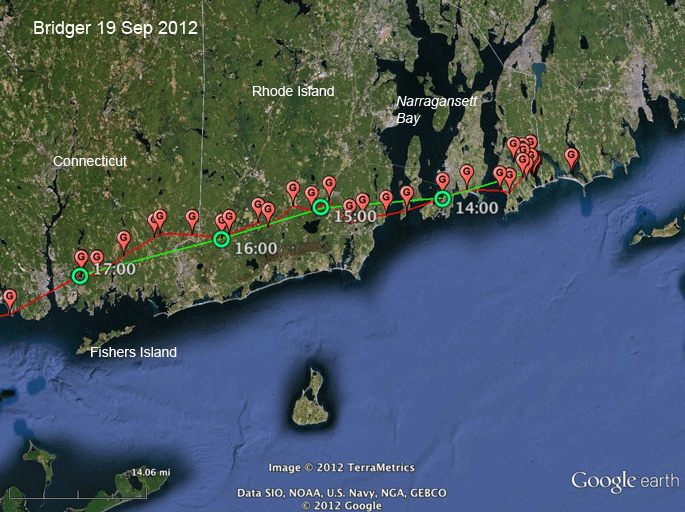 |
19 Sep 2012 -
Bridger started migrating sometime before 2 PM
(14:00). Our new cell-tower based PTTs afford us
a whole new level of resolution when following a
migrating bird. The old transmitters take a fix
every hour. To compare what the track would look
like with the satellite transmitters, I plotted
a course for Bridger based only on locations at
or near the hour. One can see here that we're
getting as many as five locations per hour, so
we can see that he's not following the straight
line that connects the hourly fixes. We'll pay attention to this as both Bridger and Rammie move south, but so far we've seen some days where they're really cruising in a very straight course that lines up nicely with the hourly points, but on other days they seem to do a lot of zigging and zagging. I suspect that on those days, the birds are using thermals and on the straight-line days, they've just got a tail wind and are just cruising with it. |
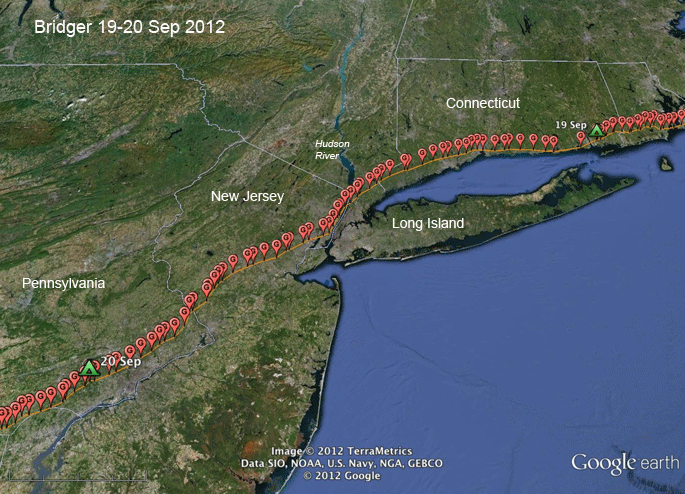 |
20 Sep 2012 - As Bridger passed through southern Connecticut, we see a really straight track, so it looks like he was cruising, and not hopping from thermal to thermal on this second day of his migration. |
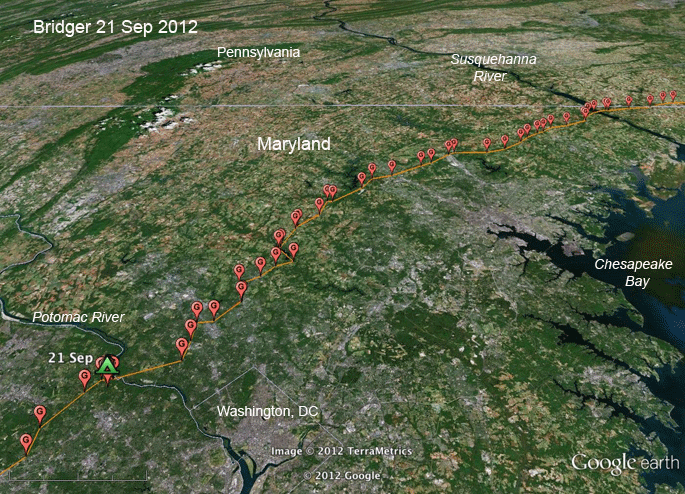 |
21 Sep 2012 -
Bridger started the day's migration in cruising
mode. As the day progressed, and thermals would
have been more available, we see a lot more
wiggle to his track. Because we get our data from text messages (like the parents of most teenagers), we need to have the birds close to a tower around midday, when they transmitters are programmed to dump data. If the birds are out over the water, or in some remote location, we may miss several days' transmissions. The GPS units do keep all the data, so the next time we hear from the birds, we'll get all the gaps filled in. We're currently in the 4th day of cell tower silence. Both birds are presumably quite a ways south of where they were on the 22nd. |
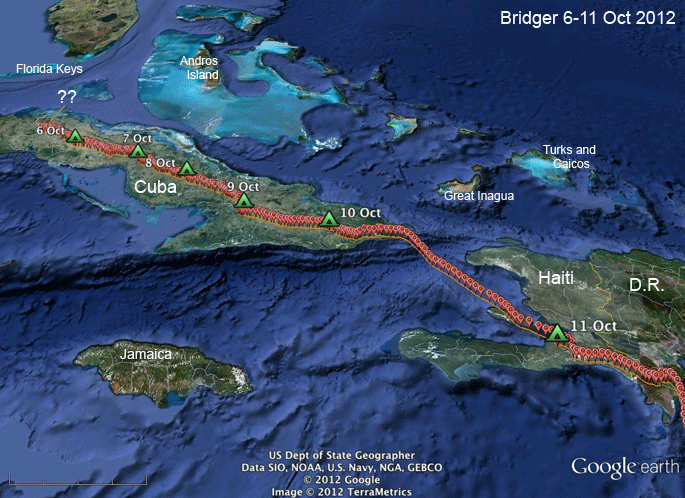 |
6-11 Oct 2012 -
Bridger resurfaced almost a month after we got
the last signal from him back on 20 Sept. We don't know how he got to Cuba, but once there, he moved through the island in just 4 and a half days, roosting on the 11th in Haiti. |
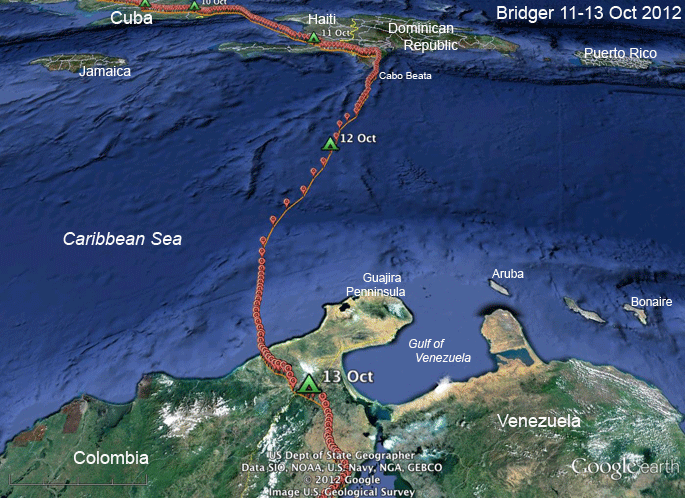 |
11-13 Oct 2012 - Bridger, like all the other birds we followed this fall, took advantage of the relatively hurricane-free Caribbean and made an easy crossing to Colombia. |
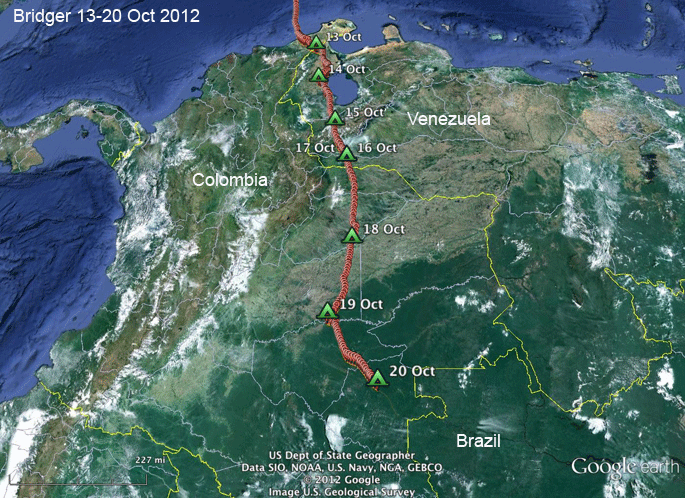 |
13-20 Oct 2012 - Bridger is heading to his winter home. We don't know where it is, but he does. I suspect we won't hear from him again for a long time, unless he flies by another miraculously located cell tower. |
 |
21 Oct 2012 - Believe it or not, there's a cell tower somewhere in this picture! |
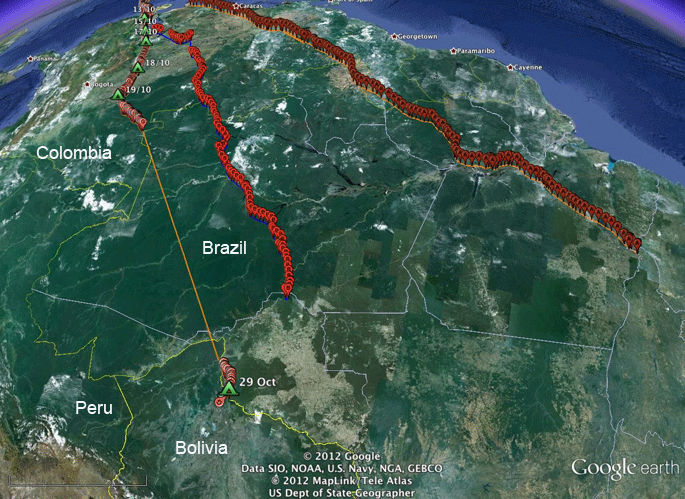 |
13-29 Oct 2012 - Remarkably, Bridger found another cell tower--this one either in Bolivia or in the Brazilian state of Rondonia. I've included in this map the tracks of Belle (red) and Art (brown), both of whom are (Belle) or probably are on their wintering waters. |
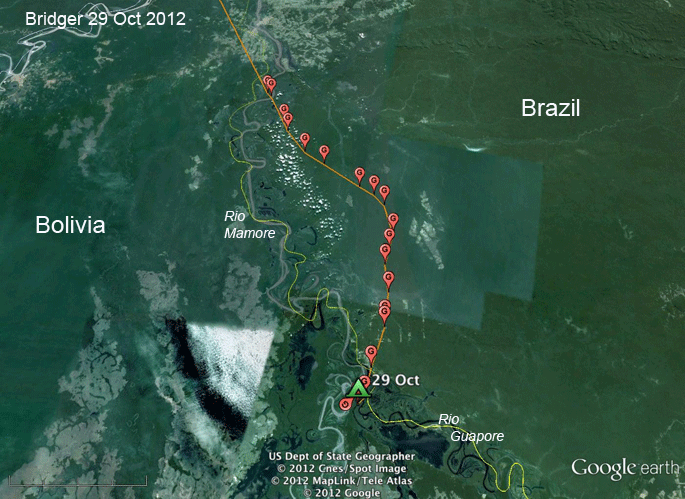 |
29 Oct 2012 - Bridger's track along the Brazilian/Bolivian border. Looking at the border (the yellow line) we can see the problems of using meandering rivers as boundaries. It looks like going down the Rio Mamore today one would cross into or out of Brazil 9 times. |
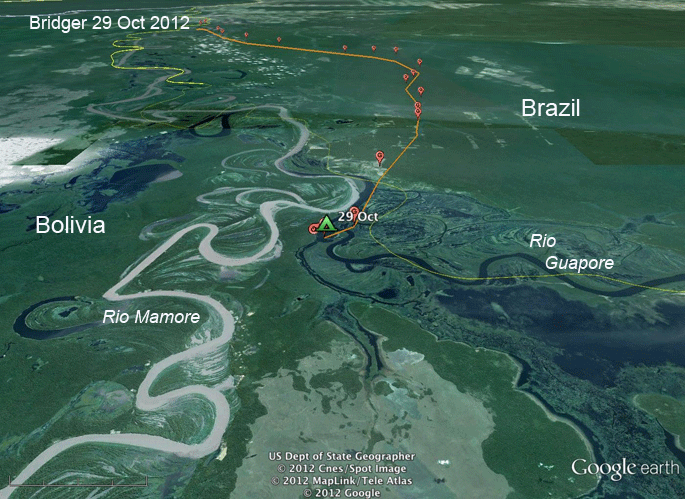 |
29 Oct 2012 - We don't know if this is where Bridger will spend the winter, but he's unlikely to go much further south and this sure looks like a good place for an Osprey to kill some time (and fish) while waiting for the next breeding season. |
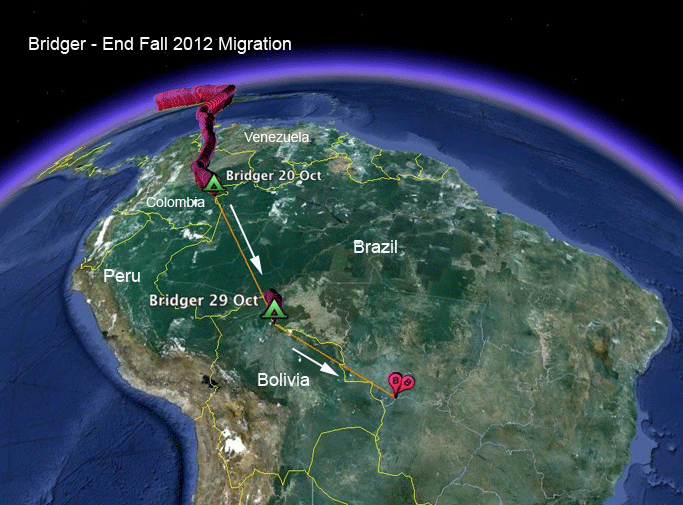 |
5 Mar 2013 - We didn't find out where Bridger spent the winter until he found a cell tower on his way north up along the Brazil-Colombia border on March 15th. We may or may not fill in the gaps in his southern track. |
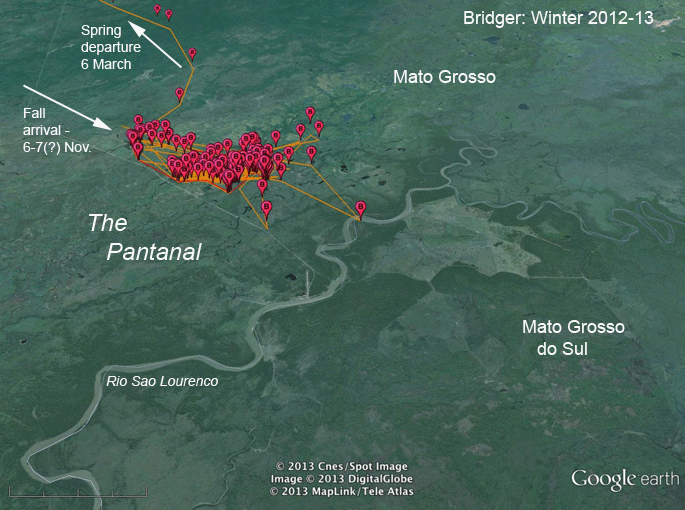 ` ` |
Winter 2012-13 -We
don't know when Bridger arrived at his wintering
grounds in the Pantanal, but it was probably
around Nov. 6th. |
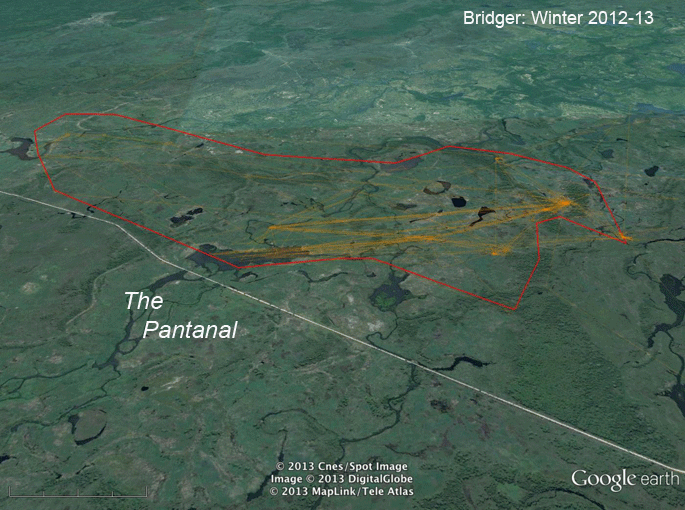 |
Winter 2012-13 -
Here's Bridger's core area outlined in red.
During the 4 months he spent here, he used an
area of only about 6 square miles (15 km^2). This is clearly a great spot for an Osprey--lots of good fishing holes. It is pretty far south, however, so most Ospreys don't get this far down the continent, although some migration overachievers do go as far as Argentina. |
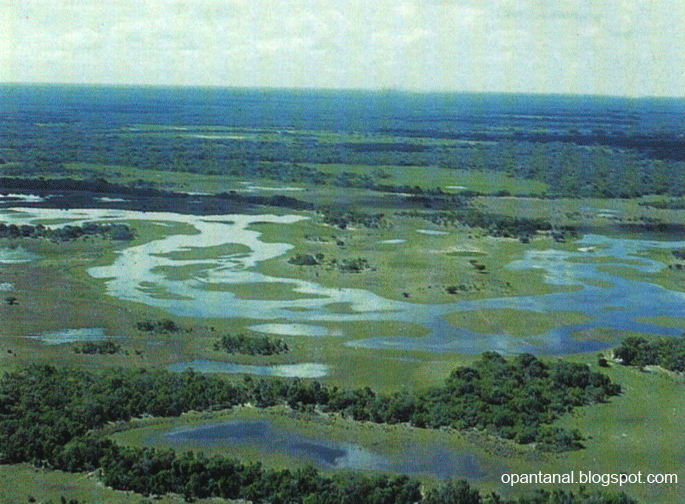 |
The Pantanal
is one of the world's largest tropical wetlands
with an area of somewhere between 140,000 and
195,000 square kilometers (54,000 and 75,000
sq mi). Most of it is in the Brazilian state of
Mato Grosso ("Thick Woods") do Sul, but it
extends up into Mato Grosso (where Bridger was)
and over into Bolivia and Paraguay. If you ever have a chance to go there on a nature tour, do it! It is bird-watching paradise. Tons of big waterbirds, Hyacinth Macaws, lots of big mammals, and a lifetime supply of caiman sightings. |
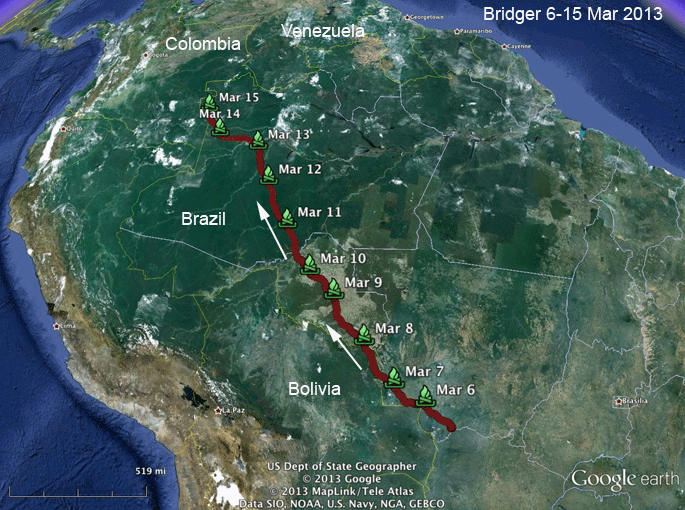 |
Heading home! Bridger left his winter home in the Pantanal on March 6th. For the next 9 days he was a migrating machine. In 9 days he covered 1,366 miles (2,199 km), averaging (with little day-to-day variation) 150 miles (244 km) per day. |